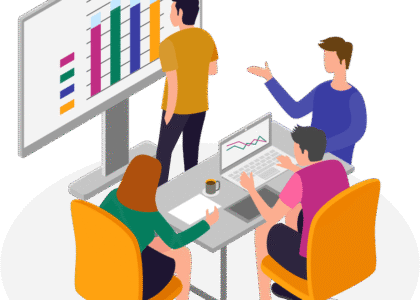In the fast-paced world of financial markets, decisions are made in microseconds, and a single fluctuation can have rippling consequences. Traders and institutions alike are increasingly relying on intelligent systems that can process vast amounts of data, uncover patterns, and execute trades with unmatched speed. At the heart of this evolution lies the convergence of AI (Artificial Intelligence) and ML (Machine Learning) with trading software development.
This transformation is not merely about automation. It’s a paradigm shift that is redefining how trading platforms are built, how they behave, and how they evolve with market behavior. Let’s explore how AI and ML are playing a transformative role in the architecture, logic, and performance of modern trading platforms.
Understanding Modern Trading Software Development
Before diving into the impact of AI and ML, it’s essential to understand what modern trading software development entails. At its core, trading software enables users to analyze markets, place trades, manage portfolios, and monitor financial instruments in real time. It can range from simple mobile trading apps to complex institutional-grade platforms used by hedge funds and banks.
Key features typically include:
-
Real-time data streaming
-
Risk management and compliance tools
-
Advanced charting and analytics
-
Order execution and routing
-
Algorithmic and automated trading capabilities
Modern development in this space isn’t just about clean UI and snappy UX. It’s increasingly about intelligent backend systems that can make sense of noisy data and empower users to make faster, smarter decisions.
The AI Revolution in Trading Software
Artificial Intelligence is fundamentally about creating machines that mimic human intelligence. In trading, this translates into platforms that can learn from past market behavior, detect anomalies, adapt to shifting trends, and make predictions—all with minimal human intervention.
Here are some key ways AI is making an impact:
1. Predictive Analytics & Forecasting
AI-driven systems can process years of historical data alongside real-time information to predict future market trends. Through time series forecasting, sentiment analysis, and statistical modeling, AI models can offer predictive insights that guide both human traders and automated strategies.
For example, by analyzing social media sentiment, news headlines, and historical price movements, an AI-powered platform can forecast volatility spikes or anticipate bullish trends before they’re reflected in the market.
2. Intelligent Automation & Trading Bots
One of the most significant applications of AI in trading software development is the rise of intelligent bots. These bots aren’t just rule-based executors; they can adjust their behavior based on real-time feedback and learning algorithms.
Instead of executing a static set of instructions, ML-driven bots can:
-
Recognize changing patterns
-
Modify their strategies dynamically
-
Avoid repeating unprofitable trades
-
Optimize order size and timing based on market liquidity
This kind of adaptability dramatically enhances trade efficiency, particularly in high-frequency or quantitative trading environments.
3. Sentiment Analysis and Natural Language Processing (NLP)
Financial markets are highly sensitive to global events, regulatory changes, and investor sentiment. AI tools powered by NLP can scan thousands of news articles, financial reports, and even tweets to assess public sentiment about stocks, commodities, or entire markets.
By incorporating sentiment scores into trading decisions, platforms can gain an edge—sometimes even minutes ahead of major movements—giving users a powerful competitive advantage.
4. Fraud Detection and Risk Management
Risk is a constant in trading. Whether it’s credit risk, market risk, or operational risk, AI can help mitigate exposure through anomaly detection and pattern recognition.
Machine learning models can:
-
Flag suspicious activities
-
Detect irregular trading behaviors
-
Prevent market manipulation
-
Help ensure compliance with ever-evolving regulations
In an industry where milliseconds matter, early fraud detection and preemptive risk mitigation are invaluable.
Machine Learning’s Learning Loop
The “learning” in machine learning is what differentiates it from traditional programming. ML algorithms improve with exposure to data. The more historical and real-time data they consume, the better they get at recognizing patterns and anomalies.
This learning loop is critical in trading where markets evolve, new variables enter the fray, and old strategies become obsolete. Whether it’s classifying bullish vs. bearish conditions, identifying arbitrage opportunities, or clustering similar trading instruments, ML models continuously adapt, improve, and refine their performance.
Key ML techniques used in trading platforms include:
-
Supervised Learning (for classification and prediction)
-
Unsupervised Learning (for clustering and anomaly detection)
-
Reinforcement Learning (for strategy optimization over time)
These models are particularly effective in algorithmic trading, portfolio optimization, and real-time signal processing.
Personalization and User Experience
AI doesn’t just operate behind the scenes. It also enhances the user experience. Modern trading platforms can tailor dashboards, alerts, and educational content based on the user’s trading history, preferences, and risk profile.
Imagine a dashboard that rearranges itself based on your most-watched assets, sends proactive alerts based on your risk appetite, and recommends strategies or learning resources based on your goals. That’s AI-powered personalization at work.
Scalability and Cloud-Based Development
AI-powered trading software is often deployed on scalable cloud infrastructure. This allows platforms to handle massive volumes of data and support thousands of concurrent users with low latency.
Modern trading software development is increasingly leaning into microservices architecture, containerization, and real-time data pipelines. AI models, meanwhile, are deployed as scalable services—capable of training, inference, and updates without disrupting user activity.
This synergy between smart infrastructure and intelligent algorithms is what sets cutting-edge trading platforms apart from legacy systems.
Challenges in Implementing AI in Trading Platforms
While the benefits are immense, integrating AI and ML into trading software development is not without challenges:
-
Data Quality: Poor-quality or biased data can lead to flawed models.
-
Model Overfitting: A model too tightly fit to past data might perform poorly on new, unseen scenarios.
-
Regulatory Constraints: Financial regulations can limit the kind of AI tools that can be deployed in certain regions.
-
Black Box Nature: Many ML models (especially deep learning) are hard to interpret, making transparency a challenge.
To overcome these, developers must prioritize model explainability, robust testing environments, and compliance-focused development.
Future Outlook
The role of AI in trading is still evolving. As quantum computing, federated learning, and edge AI mature, the next generation of trading platforms could be even more autonomous, responsive, and personalized.
We’re heading toward a future where AI not only assists traders but becomes a co-pilot—actively collaborating in strategy development, execution, and optimization.
Final Thoughts
The fusion of AI and ML with trading software development is transforming how traders operate and how software is architected. From smart automation and predictive analytics to real-time risk monitoring and personalized UX, AI is embedded across the lifecycle of trading platforms.
As this landscape evolves, companies involved in building intelligent, responsive, and scalable trading software must align their development approach with these innovations.
At fx31 labs, we specialize in advanced software engineering, including AI-powered trading platforms and custom enterprise application development. Our team ensures that the software we build is not just functional, but future-ready—intelligently designed to evolve with markets, regulations, and user needs.






